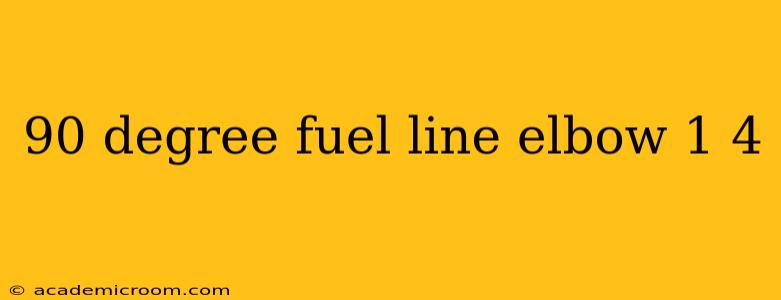Finding the right 90-degree fuel line elbow for your application can be crucial for both performance and safety. This guide will delve into the specifics of 1/4" fuel line elbows, covering various materials, applications, and considerations for selection.
What is a 90-Degree Fuel Line Elbow?
A 90-degree fuel line elbow, also known as a fuel line bend or fuel hose elbow, is a fitting used to create a right-angle turn in a fuel line. The 1/4" designation refers to the inner diameter of the tubing it's designed to connect. These elbows are essential components in automotive, marine, and other applications where fuel needs to be routed efficiently and safely.
Types of 1/4" Fuel Line Elbows: Materials and Construction
The material of a 1/4" fuel line elbow is a critical factor determining its durability, chemical resistance, and compatibility with different fuels. Common materials include:
- Nylon: Often chosen for its flexibility and resistance to many chemicals. However, nylon elbows may not be suitable for high-pressure applications or extreme temperatures.
- Steel: Offers superior strength and durability, making it ideal for high-pressure fuel systems. Steel elbows may require additional corrosion protection depending on the environment.
- Aluminum: Provides a lightweight yet strong option, particularly useful in applications where weight is a concern. Aluminum's corrosion resistance is generally good, but it can be susceptible to certain chemicals.
- Brass: Known for its excellent corrosion resistance and machinability, making it suitable for a wide range of applications. However, brass can be softer than steel, making it less ideal for high-vibration or high-pressure situations.
The construction also varies. Some elbows are one-piece molded, while others consist of multiple parts that are joined together. Consider the method of connection: push-to-connect, compression, or flared fittings. Each method offers varying levels of security and ease of installation.
Choosing the Right 1/4" Fuel Line Elbow: Key Considerations
Selecting the appropriate 1/4" fuel line elbow requires careful consideration of several factors:
What type of fuel will it carry?
Different fuels have different properties, and some may react negatively with certain materials. Ensure the elbow is compatible with the specific fuel being used. Consult the manufacturer's specifications for compatibility information.
What is the operating pressure and temperature?
The elbow must withstand the pressure and temperature conditions of the fuel system. Exceeding the specified limits can lead to leaks or failure, potentially causing serious damage. Always check the manufacturer's specifications for pressure and temperature ratings.
What is the installation environment?
The installation environment will influence the material choice. For example, a marine application may require a material with exceptional corrosion resistance. Similarly, an environment with high vibrations may need a more robust elbow.
What are the connection methods?
Ensure the elbow's connection method is compatible with your fuel lines and other fittings. Common connection methods include push-to-connect, compression, and flared fittings. The choice often depends on factors such as ease of installation, system pressure, and the type of fuel line used.
Where to Buy 1/4" Fuel Line Elbows?
1/4" fuel line elbows are readily available from various automotive parts stores, online retailers, and specialty fuel system suppliers. It's essential to purchase from reputable sources to ensure the quality and safety of the product.
Frequently Asked Questions (FAQs)
What are the dimensions of a typical 1/4" fuel line elbow?
The exact dimensions can vary slightly depending on the manufacturer and the specific design, but the 1/4" refers to the inner diameter of the tubing. The overall dimensions will depend on the type of fitting (e.g., push-to-connect, compression, etc.).
How do I install a 90-degree fuel line elbow?
Installation methods vary depending on the type of fitting. Refer to the manufacturer's instructions for specific installation procedures. Generally, proper installation involves ensuring a secure and leak-free connection. Always remember safety precautions when working with fuel lines.
Can I use a 1/4" fuel line elbow for other applications besides fuel lines?
While primarily used for fuel lines, a 1/4" elbow could be used for other applications involving liquids or gases, provided the material is compatible and the pressure and temperature ratings are sufficient. However, it's crucial to ensure compatibility before using it for any other purpose. Using an incorrect fitting could lead to leaks or damage.
How can I tell if my fuel line elbow is leaking?
Look for visible fuel leaks at the connections, or smell fuel in the vicinity of the elbow. A significant leak will usually be noticeable, but small leaks can be harder to detect and require careful inspection.
This guide provides a comprehensive overview of 90-degree fuel line elbows, specifically focusing on the 1/4" size. Remember always to prioritize safety and follow manufacturer instructions when working with fuel systems.
